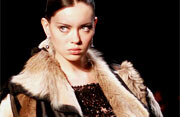As Fashion Week gets underway in New York City today, it is worth asking where models' standards of beauty come from.
Our story starts with the Barbie doll, whose U.S. sales have dropped 12 percent this quarter, leading Mattel to pin its hopes on markets abroad. Since her introduction at the 1959 Toy Fair in New York, Barbie's ultrafeminine thermoset plastic figure has climbed to number 43 on the list of 101 Most Influential People Who Never Lived.
A topic of controversy, Barbie's frame in life-size proportions would have a bust between 38 and 40 inches, a waist between 18 and 24 inches, hips between 33 and 35 inches, and a weight of a mere 110 pounds. Such a body would force her to walk on all fours.
When the competing Emme doll by Tonner Doll Co. came on to the market in 2002 with significantly more reasonable proportions it looked like Barbie would have to gain some weight. Unfortunately for Emme, her sales were a fraction of Barbie's annual $1.5 billion. About 1.5 million Barbie dolls are sold every week.
In the Middle East, Barbie dolls have disappeared from toy store shelves. In their place is Fulla, a dark-eyed doll with Barbie-like proportions, wearing a black abaya or a head scarf and embodying "Muslim values." For China, Yue-Sai Kan, creator and founder of Yue-Sai Kan Cosmetics, created an Asian version of Barbie, the Wa Wa. The doll's face has a wider, flatter nose, darker eyes, a porcelain skin tone, and a thinner body.
Wa Wa, Fulla, and Barbie have three things in common: They are all made out of plastic, they are all considered beautiful, and they all have dramatically low weights. Strutting in parallel are the thin models fashion designers choose for their catwalks and ad campaigns.
The fashion industry is known for selling mod dresses and $1,000 stiletto heels. But it is also selling the ideal of beauty embodied by the models that wear the designs.
Thin and pale may be the dominant aesthetic standard of global fashion, but preferences for ideal female frame and color differ dramatically around the world. Many cultures value the voluptuous and associate it with health and motherhood, while other cultures see richness of skin tone and a long neck as symbols of wealth or status. Translation of the famous song "The Girl from Ipanema" illustrates one of these cultural differences. In the English version, the lyrics describe the girl as "tall and tan and young and lovely," while in Portuguese the emphasis is not on her height or youth, but on her graceful swaying hips.
Diversity does not flourish in the fashion industry, as the Wall Street Journal noted today. In the recent presentations of designers' spring 2008 collections no more than one third employed black models. "Modeling is probably the one industry where you have the freedom to refer to people by their color and reject them in their work," said Bethann Hardison, a former model who runs an agency that promotes diversity.
The fashion industry as a whole is resisting change. Many argue that it is necessary for models to look alike, almost robotic, with blank features and indistinct body characteristics that don't compete with the clothes.
But formal rules were recently passed in Spain, requiring models to achieve an objective measure of health. The Council of Fashion Designers of America, following in Spain's footsteps, has issued guidelines to designers to promote healthier behavior, including the identification of models with eating disorders and the addition of nutritious backstage catering.
On the low model weight issue, designer Diane von Furstenberg says the industry "should promote health as a part of beauty rather than setting rules." Designers in France assert that a formalized response is not necessary. They argue that existing labor laws require foreign models to be registered with local agencies, and that these agencies are charged with the role of identifying models with eating disorders.
The days of anorexic-thin models are not coming to an end as swiftly as physicians or anthropologists or Spain would like. When it comes to beauty, does globalize equal homogenize? Perhaps someday the plastic doll or the model will mirror diverse and obtainable standards. Because women's health is on the line, it's interesting to note that Ruth Handler, the creator the Barbie doll, went on to invent "Nearly Me," the first prosthesis with a natural slope for breast cancer survivors.
![]() This article is licensed under a Creative Commons License.
This article is licensed under a Creative Commons License.
Please read our usage policy.




